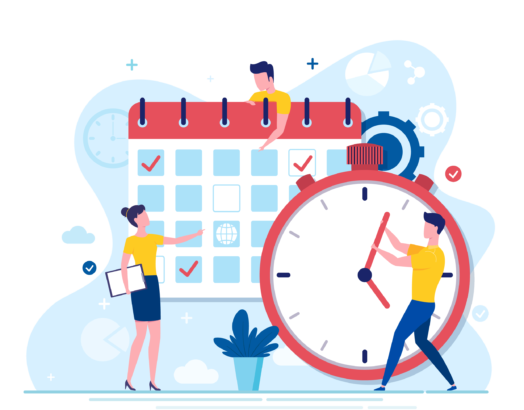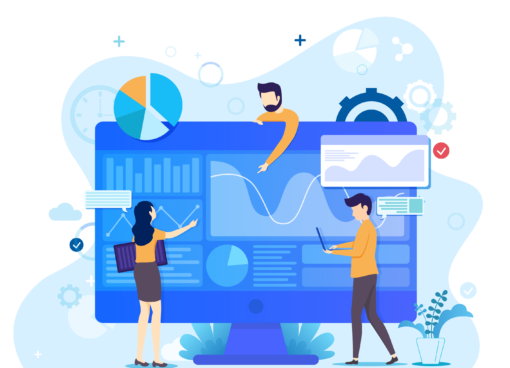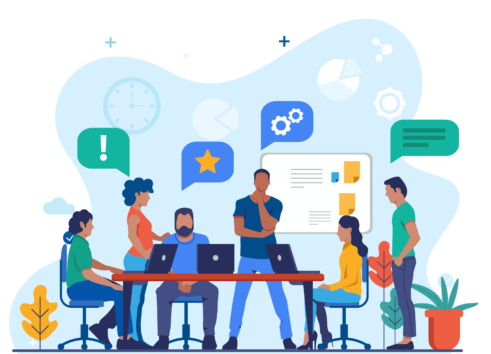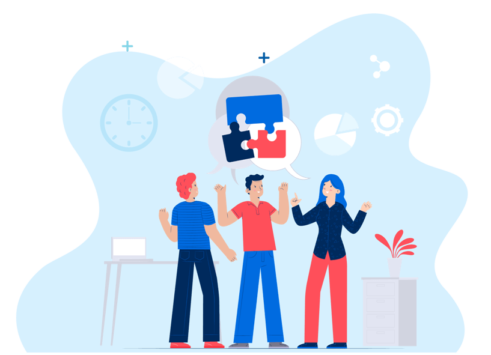How to Implement Salesforce Successfully
A Comprehensive Guide to
Salesforce Implementation
If your company does not already use a CRM to track or manage customer information, simplify repetitive tasks, improve team collaboration or close more deals – you need to implement one immediately!
Alternatively, if you are already using a CRM but plan to migrate to Salesforce CRM shortly, great choice!
Salesforce is one of the world’s most popular CRM (Customer Relationship Management) solutions and with good reason! According to salesforce.com, customers who implement Sales Cloud (one of the many products available under the Salesforce CRM umbrella) report an average 37% increase in revenue post-implementation as well as 45% higher customer satisfaction and 43% better ROI from their marketing initiatives.
That said, Salesforce implementation can be a significant undertaking. Do it right, and you can reap all the benefits we have already enumerated above (and more!). But do it wrong, and the implementation of Salesforce can cost your firm thousands of dollars, if not more.
We have put together this comprehensive Salesforce implementation guide guide to simplify the process for you and ensure that you achieve your business success with Salesforce CRM. We will cover everything from how to find Salesforce implementation partners to best practices for Salesforce implementation. . We will also guide you on Salesforce implementation costs and provide Salesforce implementation checklists. checklists.
The world’s best-known companies – from Adidas, Canon, and T-Mobile to Amazon Web Services (AWS), Philips, and Toyota – use Salesforce CRM to attract more customers, deliver better experiences, and improve customer support processes more responsive. That is why Marc Benioff, the CEO of Salesforce, proudly states that the company has over 150,000 customers of all sizes and industries. This is not a number to be sneezed at!
Part 1
Part 2
Part 3
Part 4
Part 5

Planning and Preparation
Before implementing Salesforce, plan!
Before you dive head-first into the implementation of Salesforce CRM, you need to plan and prepare for the project.
With a clear plan, you can articulate your company’s vision and prioritize your goals for Salesforce implementation. You will identify your essential resources and tools and identify necessary dependencies that may play a role in delaying implementation. Finally, your plan will make it easier to execute steps in the proper order, communicate with stakeholders (e.g., team members), and work towards a precise end date.
If you hire an external Salesforce implementation consultant (Registered Salesforce Consulting Partner or freelancer), they can do this part for you.
1. Set and prioritize your goals
Start with a clear vision. Where do you want to be as a result of the project? If you don’t know your idea, you will find it challenging to define a clear purpose, ensure team commitment, and measure post-implementation results.
Once your vision is defined and documented, define the goals that support it. You can have more than one goal, but you must prioritize them based on needs and objectives. To do this, define critical aspects of your processes (characteristics, flow, dependencies, etc.), gather requirements from your business/end users, and ‘map’ this information to the overall vision of the Salesforce implementation project.
2. Organize your Salesforce implementation team
As long as you identify and involve the right people in the process, it doesn’t always take a massive team for Salesforce implementation,.
At the minimum, try and include the following participants:
- Project sponsor: Executive-or management-level person who drives and supports the project from start to finish
- System administrator: to manage Salesforce CRM activities and maintenance from day to day
- Project manager: to lead the implementation initiative and keep it on track as per the plan
- Power users: People who can help ensure that the project will meet the needs of end-users (including management)
- Trainers: People who can find relevant training material from salesforce.com or develop custom materials from scratch
Communicating with your end-users right from the beginning is a good idea to get buy-in and ensure that implementation and adoption are as smooth as possible. Ideally, all central communication should come from the project sponsor.
Also, ensure that your administrator is trained in every aspect of Salesforce CRM used in your organization. They can leverage the free virtual training (self-paced) available on trailhead.salesforce.com or look to other sources.
3. Understand and gather your existing data
Every company has data in some form, whether it resides on an existing CRM or is maintained on spreadsheets.
Review, clean up and map this data early on. When you do, you will be in an excellent position to understand if you are tracking crucial data. You will also be able to identify if you should be monitoring some data but, for some reason, are not.
If you ignore this step, data can become a bottleneck later and delay your Salesforce implementation project. Ensure you don’t load this data until your system setup is complete (including the role hierarchy, sharing model, and sharing rules).
4. Decide which reports you will need
Based on the goals defined earlier, decide which reports you will need to generate.
Salesforce CRM provides dozens of standard reports you can modify per your needs. You can even create your reports from scratch. Make sure you know what information you want to capture before you start customizing the application. The more you know now, the easier it will be later!
5. Decide on an implementation approach
Your Salesforce implementation strategy will depend on the type and current state of your business processes.
Several methodologies are available – Waterfall and Scrum being two of the most popular. Salesforce.com uses the more ‘iterative’ Scrum approach for its development projects.
In general, most enterprises start with the Waterfall method for the initial release and then move on to a more Agile approach to schedule regular major and minor releases. Choose the system that can work best for you.
Also decide if you want to:
Take defined processes as ‘Salesforce implementation best practices and then tailor your current processes to them.
OR
Redefine your current processes and re-design them within Salesforce from scratch
The latter approach is more complex, but your option depends on your vision and goals and whether you do it yourself or hire a Salesforce implementation consultant like SaaSnic.
6. Build a project timeline
Once you have completed all the above steps, build the project timeline. Estimate the Time and effort required to design, develop and deploy Salesforce CRM based on whether your organization’s out-of-the-box functionality is enough (low effort) or if you need custom development/integration (high action).
Prioritize the requirements and check if any tasks can be done in parallel (e.g., cleaning, mapping, and loading data).
Wrap up & Checklist: Planning & Preparation
- Define a clear vision
- Identify the goals as per business processes and objectives
- Organize the team and identify key stakeholders
- Communicate with end-users from the beginning and from time to time
- Train the administrator(s)
- Keep existing data ready for implementation Understand reports and decide which ones are required
- Select an implementation approach
- Build a project timeline with estimates and priorities

Understand Costs
Arm yourself with knowledge of costs
Now that your planning is ready, you have a good idea of what you want, why, and when.
But you’re not quite ready to jump into implementation and deployment. Before undertaking Salesforce implementation,, you need to figure out the expected costs.
You will also need to consider if you want to do the implementation in-house or find a partner, i.e., a Salesforce implementation consultant (a firm or an individual freelancer).
In general, your cost for implementation of Salesforce will depend on 3 main factors:
1. Whom you hire
2. Your organization’s size and needs (number of user licenses, customizations required, etc.)
3. Ongoing maintenance expenses
1. Whom you hire
Based on your goals and objectives, you will need to build, integrate or customize some (or all) elements in the platform. But unless you have the in-house expertise to manage the complete Salesforce implementation cycle, you will have to hire someone to do it for you. Almost all Salesforce implementation consultants charge an hourly rate, whether they are firms or individual freelancers.
A. Hire a firm
Pros
A Registered Salesforce Consulting Partner like SaaSnic brings Salesforce’s guarantee that they have the necessary skills and expertise to manage your implementation project. Moreover, the firm will include developers, business analysts, administrators, and architects, so you know that each aspect of the project will be taken care of, with a clearly-defined process, milestones, and end date.
Cons
The biggest con, of course, is that because they provide multiple Salesforce implementation services (planning, configuration, customization, integration, etc.), they are not cheap. See below!
Cost
In general, any Salesforce implementation consultant will charge between US$150 and US$250 per hour.
How to find a registered Salesforce Consulting Partner
If you have decided to go with a registered firm rather than a freelancer, a good place to start is the AppExchange portal on salesforce.com.
Search under Consultants and you will find thousands of consultants to choose from, based on their popularity, rating and number of certified experts.
To narrow down the list, talk to someone you know who uses Salesforce in their company and ask for their recommendations.
You can also ask a Salesforce Account Executive (the Salesforce employee negotiating the terms of your deal with you) for their inputs.
Do your own research as well.
- How well-known is the company?
- What kind of experience and expertise does it have with Salesforce implementation services?
- Does it have positive reviews? Even better, can it provide testimonials from happy customers?
Narrow your list to 3-4 such firms and then talk to them in person to make your final decision.
B. Hire a freelancer
Pros
If cost is your most significant consideration, then hiring a freelancer is another option. They sometimes offer flexible pricing and payment terms that may work well with your budget and objectives. Equally important, freelancers will usually be more responsive to your needs because their business thrives on (your) positive reviews and repeat business.
And if your needs are not too complex, a freelancer offers a single go-to source for your project, which brings agility and flexibility to your implementation project.
We quickly searched for ‘Salesforce developer’ on one of the world’s most popular freelance platforms, Upwork. We found considerable variations in freelancers’ profiles and rates, ranging from $3/hour to $250/hour.
Freelance’ offshore’ consultants based in developing countries like India tend to charge less than ‘onshore’ consultants in the USA, Australia, or Europe.
Knowing this gives you more options and greater flexibility in the choices that are available to you.
Cons
Salesforce is massive (look at salesforce.com, and you’ll get a good idea!). No single person can have expertise in every aspect of configuration, customization, and integration, so you might have to hire more than one freelancer for your Salesforce implementation project.
If you find one who can do everything, they may be as expensive as registered Salesforce implementation consultants. Moreover, with a single resource, implementation timelines will be longer.
In summary:
| Cost of hiring a freelancer | Cost of hiring a Salesforce Registered Partner | Our Costing as a Registered partner |
|---|---|---|
| $3/hour to $250/hour | $150/hour to $250/hour | $25/hour to $90/hour |
2. Your organization’s size and needs
The size of your organization and your CRM needs will determine how many Salesforce licenses you will need, i.e., the number of end users who will use Salesforce. Salesforce CRM pricing differs for different solutions/products depending on your organization type and objectives.
For example, if you are a Small Business, Salesforce provides four solutions with this Pricing structure:
So if you need a sales and customer support solution for (up to) 10 users, you might choose the Essentials package at $25/user/month.
So your annual cost for the Essentials package (10 users): 10 x 25 x 12 = $3,000
Salesforce Essentials edition can be purchased with a monthly or annual contract. The other subscriptions are generally paid annually and in advance. You can sign up and purchase Salesforce Essentials directly from a free trial to get started. You will be prompted to buy or contact Salesforce for more information when your trial expires.
For further details on pricing, check out Salesforce.com here.
3. Ongoing maintenance expenses
Even after you have completed the implementation of Salesforce, you will still incur costs in its maintenance and upkeep.
You will need Salesforce admins to manage your Salesforce org, train your team on how to use it, maintain data quality, extract and analyze reports, etc. Therefore, in addition to your annual Salesforce license expenses, you should also budget for a full-time Salesforce admin. You might even need more than one admin, depending on your organization’s size and location, and the complexity of your Salesforce platform.
According to Glassdoor, Salesforce administrators in the USA earn an average salary of about $87,000 ($95,000, according to Salesforce Trailhead). In the UK, the average salary for a Salesforce admin is 36,000 GBP (approx $44,000).
Total Time + Total Costs
In a very useful article, David Berman, a Salesforce CRM consultant, breaks down a Salesforce implementation project into 5 ‘mini-projects’ and assigns an estimated number of hours to each:
| Mini-project | Time estimate |
|---|---|
| Base CRM set-up | 15-20 hours |
| Legacy data clean-up/de-duplication | 30-60+ hours |
| Importing the clean data | 12 hours |
| Customizations and integrations | 15-80 hours |
| Training | 35 hours |
| TOTAL | 107-207 HOURS |
Now, if you purchase the Essentials package for ten users, here’s how you can estimate the total cost for your Salesforce implementation project:
| MINIMUM COST | |
| Annual cost for 10 user licenses | $3,000 |
| Annual salary for Salesforce administrator (USA) | $87,000 |
| Cost of hiring a low-end freelancer OR Cost of hiring a low-end registered partner | $3 x 107 = $321 $150 x 107 = $16,050 |
| TOTAL COST | $90,321 – $106,050 |
| MAXIMUM COST | |
| Annual cost for 10 user licenses | $3,000 |
| Annual salary for Salesforce administrator (USA) | $87,000 |
| Cost of hiring a high-end freelancer OR Cost of hiring a high-end registered partner | $185 x 207 = $38,395 $250 x 207 = $51,750 |
| TOTAL COST | $128,395 – $141,750 |
Wrap up & Checklist: UNDERSTAND COSTS
- Hire a freelancer or Registered Salesforce Consulting Partner like SaaSnic
- Analyze and document your organization’s needs: package type, modules, etc
- Estimate the hours required to complete implementation
- Purchase relevant package and licenses from salesforce.com
- Hire a Salesforce administrator

Implementation
A step-by-step execution plan
Now that you have the basics in place – goals, team, budget, implementation vendor – you are ready to start implementing Salesforce in your organization. Follow a step-by-step approach and your execution will be flawless and perfectly aligned with your plan.
1. Set up your company profile
This should include information like language, time zone, fiscal year (critical for reporting!), etc.
2. Set up access levels and permissions for your users (components + data)
In Salesforce CRM, data access is based on organizational role hierarchy, sharing rules, manual sharing or organizational-wide defaults. Create user profiles to control how users can view the information and what they can do (permission) with the data they have access to.
Three of the most important profiles that almost all Salesforce customers create in their organizations are:
- System Administrator: Has permission to configure and customize the application
- Standard User: Can create records and run reports. They can also edit records if they have permission
- Read-only: Can run and export reports, and can view records (but not edit)
Remember that during this stage, you are only setting up access levels, creating user-profiles and deciding on permissions. Adding users comes later (see below).
3. Customize Salesforce CRM for your organization’s needs
You can use Salesforce with its default features and functionalities. However, the chances are that you want to customize it to meet your specific needs and goals. These details are already captured in your plan. Now it’s time to execute!
Most Salesforce customers customize one or all of the below features:
- Fields
- Page layouts
- Reports
Customize Fields: Modify the standard fields provided in Salesforce CRM or create your own from scratch. You can also do both simultaneously. Make sure you give field names that make sense to your users!
Customize Page Layouts: Page layouts determine which fields are required and how those fields will appear to your users. Customize them, keeping user satisfaction and usability in mind.
Customize Reports: Reports are among the most critical (and awesome) aspects of Salesforce CRM. Use standard reports or customize them based on required fields, layout, charting options, etc.
During the customization phase, you should also think about leveraging Salesforce CRM’s Lead Functionality – another amazing feature that can boost your sales process and increase conversions.
4. Add users
Now that you have customized Salesforce, set up its functionalities and defined user access levels, you are ready to add users into the system.
When you add users, you can import data and associate it with the correct users, decide how specific users will see specific data and also control what they are allowed to do within the application.
5. Import data
Use the inbuilt wizards within Salesforce CRM to import your data. Test your import on a small sample before you do the full import. Once your test results meet your expectations, you can import all your files. Ideally, do this during non-working hours, so there is no downtime or productivity loss.
Do remember to validate your data to ensure that all data is imported into the correct fields and in the right format.
Wrap up & Checklist: Implementation
- Set up your company profile
- Set up access levels and permissions for your users (components + data)
- Customize fields, page layout and reports
- Add users
- Import data

Making Your Organization Salesforce Ready
Prepare your users for adoption
Now that you’ve set up and customized Salesforce CRM for your organization, you have to get your users ready for adoption.And just like you had a plan and strategy for implementation, you should also create a plan for user adoption. This will shorten the learning curve and minimize later disruptions or downtime.
Your plan should include strategies around:
- Training
- Leadership
- Administration
- Adoption & GO-LIVE!
- Post-launch support
1. Training
No matter how well you plan and execute your Salesforce CRM implementation, the entire exercise can be a rousing failure if you don’t train your users to use it properly (and effectively).
Your Salesforce CRM will be used by multiple users who will have distinct goals and different purposes. Therefore, it’s critical that you design your training based on their roles.
Provide content that is useful and relevant to them. Make sure it is engaging and includes hands-on or scenario-based exercises.
You can use any kind of materials based on their availability and your users’ learning styles. These include:
- Slide shows
- Reference cards
- Guides
If you don’t want to create your own material from scratch, a great place to start your Salesforce training program is Trailhead by Salesforce. This portal provides training on everything from Salesforce Lightning and reports to app development.
You can choose which modules you want your users to learn. You can also select learning paths (aka Trails) based on user roles (admin, business user, developer, etc), knowledge level (beginner, intermediate, advanced) and even products (Sales Cloud, Marketing Cloud, Pardot, etc.).
2. Leadership
You should have already covered this aspect in the planning stage. However, it’s important to ensure that your users see and experience accountability, responsibility and buy-in from the organization’s leadership throughout the entire implementation journey (and even beyond).
Leadership could be:
- Someone at management level to champion the adoption of Salesforce CRM
Power users to answer questions from users that are not already covered in the training.
3. Administration
As already covered in the section on COSTS, you will need a Salesforce admin to manage your Salesforce CRM platform, modify user data, install new apps, extract reports, etc.
If your organization is large and you’re using a highly-customized Salesforce CRM with multiple modules and functionalities, you may need more than one admin to split the different tasks. Depending on your unique needs, you might hire a full-time employee or work with a freelancer or a Registered Salesforce Consulting Partner like SaaSnic.
Ideally, you should retain the services of the Salesforce admin consultant for at least 15-20 hours per week.
4. Adoption & GO-LIVE!
Now your organization is finally ready to go live with Salesforce CRM!
Follow these steps for a smooth launch. And your people might even be excited rather than wary!
- Create a Chatter post to announce go-live, and to congratulate the project team and all users who attended the training. For more information on Chatter, see this post on salesforce.com!
- Add all training material to the Chatter group
- Encourage people to provide feedback and ask questions
- Support users and actively encourage adoption by providing more information about the system’s features and benefits (automate time-consuming, repetitive tasks, streamline the sales process, improve collaboration, etc.)
- Identify user ‘champions’ and leverage their knowledge and success to inspire others
- Track and measure adoption/usage trends over time, analyze what’s working and make plans to fix what’s not working
- Promote more adoption by providing incentives
es of the Salesforce admin consultant for at least 15-20 hours per week.
5. Post-launch support
Immediately the following go-live, your users may need some additional support and training as they get used to the new solution. Ask your Salesforce implementation services provider if they offer after-launch support services for quick problem-solving or bug-fixing. Ideally, they should be on hand to help address and mitigate performance issues to comply with emerging user needs and challenges.
Through all these steps, create a communication plan to establish an ongoing dialog with your users and to ensure that any challenges that crop up (and they will!) are dealt with before they become huge problems.
Wrap up & Checklist: Making Your Organization Salesforce Ready
- Train end users
- Identify leadership and power users to champion implementation and adoption
- Hire and train admin
- Announce that Salesforce CRM is LIVE
- Encourage user adoption
- Provide post-launch support

What Next?
Get even more out of your Salesforce platform
Once you’re up and running with Salesforce CRM, you can extend it further to leverage its power and propel your organization to the next level.
On an ongoing or as-needed basis, you can:
- Introduce additional functionalities
- Provide and integrate tools like email clients, dashboards, templates and calendars
- Manage and improve data quality
- Set up and monitor data quality dashboards
- Use partner solutions from Salesforce AppExchange. These applications work with Salesforce CRM to help users increase productivity, manage leads and opportunities, generate quotes, etc.
You already know what you need, you can search AppExchange by app name. Or you can review the available apps by type, product collections or industry collections. You can even select the ones recommended by Salesforce.
Link: https://appexchange.salesforce.com/
Join the Salesforce Trailblazers community to find information, share ideas, and ask questions. You can also join the Partners community to market and sell your apps, or to connect with resources to plan and grow your business. A separate community is available for Salesforce developers to learn, share and communicate about all things related to Salesforce development, customization and integration.

